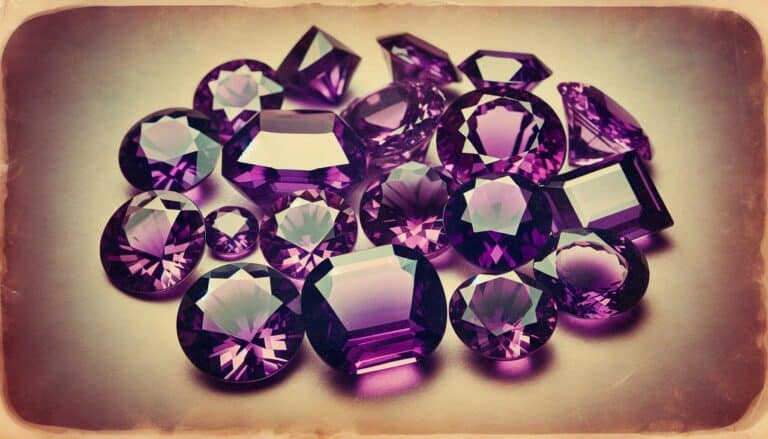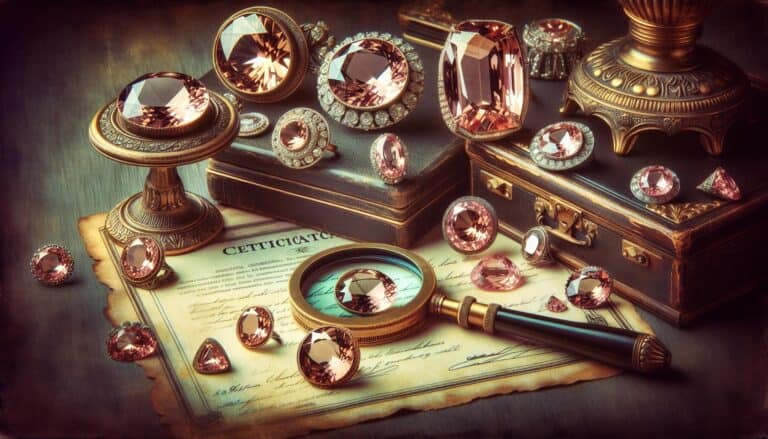Diving into the vibrant world of gemstones, you’ve likely marveled at turquoise’s unique charm.
With its alluring blue-green hues, it’s not just a staple in jewelry boxes but also a cultural icon. But have you ever wondered about turquoise’s value?
The worth of turquoise can be as layered as the stone itself, influenced by factors like color, rarity, and origin. Whether you’re a collector, a jewelry enthusiast, or simply curious, understanding what determines turquoise’s price is as fascinating as the gem.
Let’s unearth the factors that make turquoise a treasured piece of the Earth’s beauty.
Turquoise value hinges on color, clarity, origin, and treatment. Vivid sky-blue colors with minimal matrix are most valued. Rarity increases with specific origins like Iran or the Southwestern US. Natural turquoise, free from treatments, commands higher prices. Market trends and availability also affect its worth.
What Is Turquoise?
Turquoise is a captivating mineral, revered for its beauty and longevity throughout the ages. It’s a hydrous phosphate of copper and aluminium, which gives it the signature blue to green colors that you know and love. Turquoise has been a gemstone of significance across various cultures, symbolizing wealth, status, and protection.
In its natural form, turquoise is relatively soft and porous; therefore, it often undergoes treatments to enhance its color and durability. These treatments can range from waxing and oiling to stabilization with resins, impacting its value.
Mining turquoise is traditionally done in open pits or underground mines, and the geographical origin of turquoise significantly adds to its mystique and worth. The most prized turquoise comes from Iran, the Southwestern United States, and the Sinai Peninsula. Each region’s turquoise bears unique characteristics:
- Iranian Turquoise: Known for its sky-blue hues and persian legacy.
- Southwestern US Turquoise: Offers a variety of patterns and is often set in silver to create striking jewelry pieces.
- Sinai Turquoise: Historically one of the first sources of turquoise and cherished for its rich green to blue colors.
The distinctive webbing or matrix pattern that turquoise may possess is another factor to consider. This feature refers to the remnants of the host rock within the gemstone, which can range from fine veins to larger patches. While some purists prefer turquoise without these inclusions, others find that the matrix adds character and ensures that each piece is truly one-of-a-kind.
Interestingly, synthetic turquoise exists and is often sold under names like “reconstituted turquoise” or “block turquoise.” While these may mimic the appearance of natural stones, they do not offer the same value or historical significance. As you delve deeper into the world of turquoise, it’s crucial to differentiate between these varieties for informed decision-making about your collection or investment.
Turquoise Prices: Factors That Affect Value

Color, Clarity, and Cut Quality
When assessing how much turquoise is worth, the hue, saturation, and brightness of the stone’s color are vital. Highly sought-after turquoise typically has a vivid, even sky or robin’s egg blue. Stones with a greenish tint or uneven color distribution generally fetch lower prices. Clarity is another significant factor; stones with less matrix or fewer imperfections are more valuable. However, remember that the preference for matrix patterns can be subjective and may appeal more to certain collectors.
The cut of turquoise is less conventional than other gemstones due to its opaque nature but it still impacts the stone’s aesthetics and thus its value. A skillful lapidary will shape and polish turquoise to maximize its beauty, which in turn could increase its market worth.
Market Demand and Availability
Turquoise’s value is also tied to market demand and its availability. With trends in fashion and jewelry fluctuating, so does the demand for turquoise. For instance, when a prominent designer features turquoise, its popularity might spike, resulting in higher prices. Availability plays a critical role as well; high-quality turquoise is not abundant, making it more precious and expensive. The balance between a piece’s rarity and the desire for it shapes its price point in the market.
Mining locations that produce less turquoise increase the scarcity of stones from those areas, which can drive up prices. For example, material from the now-closed Sleeping Beauty mine in Arizona is considered premium due to its even blue color and lack of matrix, leading to high prices for even small carats. Keep an eye on both historical trends and current fashion inclinations to understand how they influence turquoise value over time.
Understanding Turquoise: A Rare Gem

The Rarity of Turquoise
Turquoise’s allure begins with its rarity. Unlike other gemstones that are mined in various places around the world, high-quality turquoise is found in just a few regions. The best specimens come from dry and arid lands, with the American Southwest, Iran, and the Sinai Peninsula being prime locations. These areas present the unique conditions necessary for turquoise to form, occurring in arid regions through a process called phyllization where minerals undergo changes by water and heat over millions of years.
Mining turquoise is a laborious process, and veins of the gemstone are often thin and challenging to extract. Turquoise deposits are typically small and scattered, making high-grade stones a true rarity. As mines become depleted, the scarcity of turquoise increases, thus enhancing its value. Here are some points that underscore the scarcity of turquoise:
- Prime locations are geographically limited.
- Turquoise veins are often small and require careful extraction.
- High-grade turquoise is rare and becoming rarer as mines are depleted.
Origins and Characteristics
Exploring turquoise’s origins reveals much about its inherent characteristics. Historically, ancient civilizations regarded it as a symbol of wealth and status. Historical significance adds to its value, with artifacts dating back thousands of years showcasing its long-standing appeal.
Knowing turquoise’s characteristics can help you understand its worth. Typically, turquoise forms where copper is abundant, influencing its distinctive blue-green color. The presence of aluminum and phosphorus contributes to its opacity and hardness. The stone’s unique hue can vary from a pure sky blue, known as “Persian Blue,” to a variety of greens, influenced by the amount of iron in the composition. These colors not only determine its beauty but its valuation:
- Pure sky blue hues are the most prized.
- Greenish tints typically lower the stone’s value.
- Matrix patterns, the presence of remnants of the host rock, can either enhance the stone’s appeal or detract from its clarity.
The hardness of turquoise, measured on the Mohs scale, typically ranges between 5 and 6. This somewhat delicate nature means that proper care is crucial for maintaining the stone’s integrity. Its porosity also affects its durability; higher quality turquoise is often treated to enhance its resilience and color stability.
By understanding turquoise’s rarity and unique characteristics, you’re better positioned to assess its value whether for personal acquisition or investment. Remember that turquoise’s market value is a reflection of not just current trends but its historical context and physical attributes. Keep these factors in mind as you admire turquoise jewelry or contemplate adding to your collection.
Turquoise Grading and Valuation
The Grading System for Turquoise
When looking to purchase turquoise gems, it’s crucial to understand the grading system that distinguishes quality. Unlike diamonds, which adhere to a standardized grading scale, turquoise grading is less formalized. However, experts typically categorize turquoise into three primary grades: natural, stabilized, and treated.
- Natural Turquoise is the most valuable, as it’s been excavated and shaped without any additives.
- Stabilized Turquoise refers to stones that have been treated with a resin to enhance durability, yet their color remains unchanged.
- Treated Turquoise includes pieces that have been dyed or altered to improve their color and clarity. This variety is less valuable than natural stones.
To assess a piece’s grade, look at the color and matrix. Stones flaunting a uniform, vibrant blue shade demand higher prices, while those with a spotty matrix or greenish hues are often considered of lower grade. The presence of naturally occurring patterns or matrices doesn’t inherently diminish the value – this all hinges on the overall aesthetic and consumer preference.
Certification and Appraisal
An official certification or appraisal can significantly impact the worth of turquoise jewelry. When you’re making a considerable investment, seek out certified gemologists. A reputable specialist will provide a certificate authenticating the gem’s grade and properties. The assessment of turquoise can vary based on the professional’s expertise and the methods utilized.
The appraisal process involves a detailed examination to establish the stone’s market value. Factors contributing to the appraisal include:
- Weight (measured in carats)
- Cut and shape
- Color uniformity and saturation
- Matrix patterns
- Origin and historical significance
For insurance or resale purposes, having an updated appraisal is beneficial, as the market value of turquoise can fluctuate. When choosing an appraiser, ensure they have no vested interest in the sale to guarantee an unbiased valuation. Relying on recognized institutions or independent certified appraisers will ensure you receive an accurate assessment of your turquoise piece.
Current Market Trends in Turquoise Pricing
Understanding the current market trends can give you insights into how much your turquoise might be worth. The pricing for turquoise stones fluctuates due to a variety of factors, such as fashion trends, the economy, and the mining industry’s output.
Fashion trends play a significant role, as turquoise often features in seasonal jewelry collections. Periods of high demand, typically during festivals or occasions when bohemian styles surge in popularity, can lead to price spikes. On the other hand, periods where minimalism reigns can see turquoise prices stabilize or decrease.
The global economy can influence turquoise prices too. During economic downturns, luxury goods, including gemstones like turquoise, may experience a dip in market value. Conversely, when the economy is strong, people have more disposable income, potentially increasing demand and prices for turquoise pieces.
In terms of mining output, the supply of raw turquoise impacts pricing—scarcity leads to higher prices. If mines struggle to meet demand, you’ll likely see the value of turquoise rise. Certain locales, like the southwestern United States, are renowned for producing high-quality turquoise. The stones from these mines, especially those that cease operations, can become highly sought after, leading to notable price increases.
Let’s look at some recent data to understand price trends. Here’s what you should keep in eye for:
- Mine closures: Mines shutting down lead to increased rarity and higher prices for specific types of turquoise.
- Gemstone treatments: Untreated, natural turquoise is more valuable than treated or stabilized stones.
- Cultural influences: Global cultural events or fashion trends that highlight turquoise can cause temporary boosts in price.
The table below outlines some observed pricing changes over recent years:
| Year | Average Price per Carat (USD) | Notable Market Influences |
|---|---|---|
| 2019 | 1.00 | Stable market conditions |
| 2020 | 1.20 | Increased demand for authenticity |
| 2021 | 1.50 | Mine closures & economic recovery |
| 2022 | 1.75 | Heightened fashion trends |
Remember that values may vary widely depending on the specifics of your turquoise, including factors previously mentioned, such as color and clarity. Always seek a professional appraisal for the most accurate market assessment of your gemstone.
The Most Expensive Turquoise
When you’re investigating the value of turquoise, you’ll find that certain types fetch a higher premium than others due to their rarity and quality. Sleeping Beauty Turquoise, from the now-closed mine in Globe, Arizona, consistently ranks among the most prized. Its pure, robin’s egg blue color free from inclusions sets a benchmark for evaluating other turquoise.
Another variety that often commands top dollar is the Bisbee Turquoise, noted for its deep blue color and striking chocolate brown matrix. Mined in Bisbee, Arizona, this turquoise is not only beautiful but also collectible due to the scarcity imparted by the limited operational period of the mine.
In terms of pricing, the most expensive turquoise pieces can be astonishingly valuable. Here are a few recent figures that demonstrate just how much top-quality turquoise can be worth:
| Type of Turquoise | Price Range |
|---|---|
| High-grade Sleeping Beauty | $2 – $5 per carat |
| Fine Bisbee Turquoise | Up to $10 per carat |
| Rare Persians | Over $500 for high-quality specimens |
Remember, these prices are influenced by the factors previously discussed: color, clarity, cut, and market demand. Unique or historically significant pieces can command even higher prices, especially when sold at auction or through high-end jewelry retailers.
Mining output significantly affects the rarity and subsequently the value of turquoise. With the depletion of mines like the Sleeping Beauty, the remaining stones on the market see a surge in value. The trend in luxury goods has also seen a swing towards unique and indigenous stones like turquoise, which has further positioned this semi-precious stone as a sought-after asset in the high-end market.
Compelling evidence of turquoise’s luxury status is found in the work of renowned jewelers who integrate it into spectacular pieces. Such artifacts not only reflect the current market value but also the prestige that comes with owning a piece of natural history adorned with this timeless gemstone.
Buying Turquoise: Tips and Recommendations
When you’re in the market for turquoise, knowing where to shop and how to ensure the authenticity and value of your purchase is crucial. Whether you’re a collector or simply appreciate the beauty of this prestigious gemstone, these tips and recommendations will guide you towards making informed decisions.
Where to Purchase High-Quality Turquoise
High-quality turquoise is a treasure, and finding it requires knowing where to look. You’re likely to find the best pieces in places renowned for their turquoise production. These include:
- Southwestern United States: States like Arizona, New Mexico, and Nevada have well-established stores selling local gems.
- Jewelry Expos: Trade shows often feature reputable dealers with a range of high-quality options.
- Online Retailers: While buying online can be convenient, ensure they have a reliable return policy and customer reviews.
Here’s what to look out for when you’re on the hunt:
- Reputation: Choose sellers with a strong reputation. Look for customer reviews and ratings to verify credibility.
- Specialization: Sellers specializing in turquoise will likely offer better quality stones and more information about their origin.
- Certification: Some sellers provide certificates of authenticity which add confidence to your purchase.
Ensuring Authenticity and Value
To guarantee the authenticity and protect the value of your turquoise, take these steps:
- Ask for Documentation: Reputable sellers should provide details about the gemstone’s source and treatment history.
- Inspection: Examine the stone closely. High-quality turquoise should not have any artificial coloring or resin fillers.
- Expert Opinion: Consider having the turquoise appraised by an independent gemologist for an unbiased assessment of its value.
Remember, the value of turquoise can fluctuate based on market trends and availability. Staying informed about these changes will help you make better purchasing decisions. Keep an eye out for:
- Market Trends: Follow pricing trends to understand what constitutes a fair price for the quality you’re seeking.
- Quality Factors: Always consider color, clarity, and cut –the hallmarks of a precious turquoise gem.
When investing in turquoise, you’re not just buying a gemstone but also the rich history and cultural significance it carries. With the right knowledge and a careful approach, your turquoise purchase can be both fulfilling and worthwhile. Take your time, do your research, and you’ll become a savvy collector or owner of this cherished mineral.
Conclusion: Buying & Selling Turquoise
Determining the value of turquoise isn’t just about price tags—it’s about appreciating its unique beauty and heritage.
By focusing on color, clarity, and craftsmanship, you’re well on your way to discerning quality pieces. Remember, the reputation and expertise of the seller are as critical as the gemstone itself. Don’t shy away from requesting documentation or a second opinion to confirm your turquoise is the real deal. Your attention to detail and willingness to learn market trends can transform you into a knowledgeable buyer, not just a casual shopper. Turquoise isn’t merely a stone; it’s a legacy in your hands.
So take your time, do your due diligence, and you’ll find that true worth often lies beyond the surface.





![Minnesota Rockhounding Sites in [year]: Sites & Treasures](https://observationhobbies.com/wp-content/uploads/2024/01/xm-C_w7-bWk5JVfXXKpun-768x439.jpg)
![Indiana Rockhounding Sites in [year]: Spots & Finds](https://observationhobbies.com/wp-content/uploads/2024/01/hO8R94wCsmRXbt2QdEYf6-768x439.jpg)
